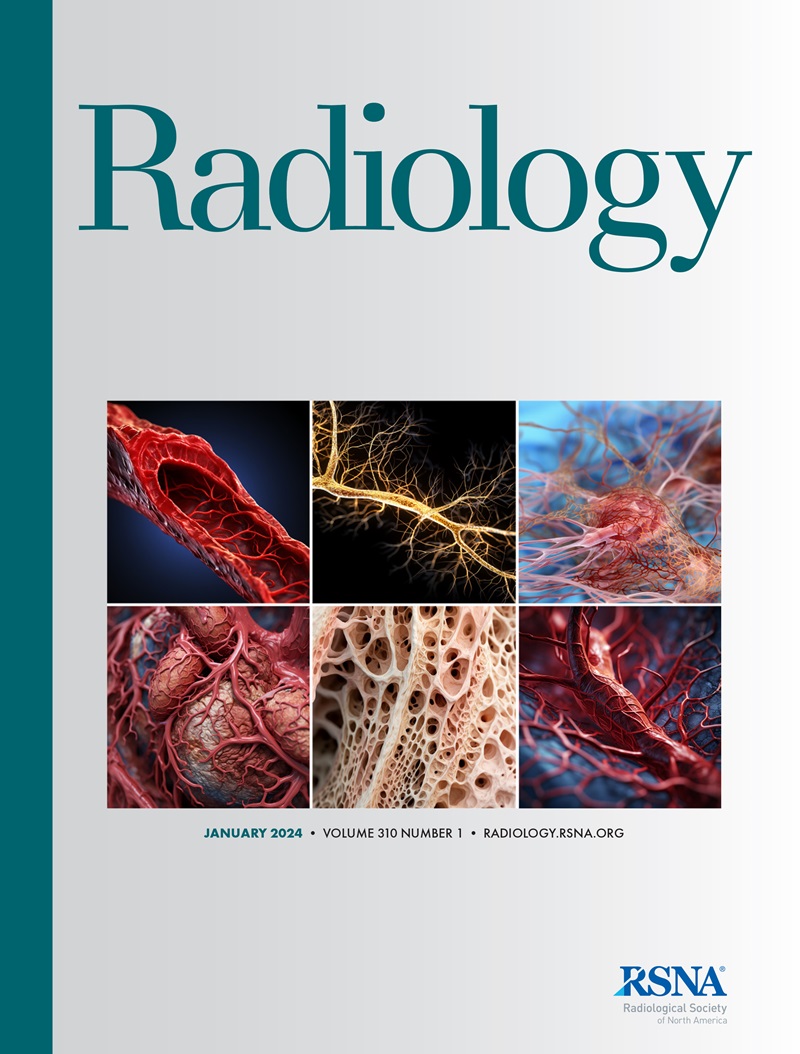Xueqin Gong, Xiaoxia Wang, Lu Wang, Xiangfei Zeng, Sun Tang, Yue Cheng, Tao Yu, Yao Huang, Ying Cao, Huifang Chen, Fujie Jiang, Shuling Liu, Lan Li, Ting Yin, Jiuquan Zhang
求助PDF
{"title":"比较多b值扩散MRI模型预测乳腺癌新辅助化疗病理完全缓解。","authors":"Xueqin Gong, Xiaoxia Wang, Lu Wang, Xiangfei Zeng, Sun Tang, Yue Cheng, Tao Yu, Yao Huang, Ying Cao, Huifang Chen, Fujie Jiang, Shuling Liu, Lan Li, Ting Yin, Jiuquan Zhang","doi":"10.1148/radiol.242969","DOIUrl":null,"url":null,"abstract":"<p><p>Background Multi-<i>b-</i>value diffusion MRI models have been used to predict pathologic complete response (pCR) to neoadjuvant chemotherapy (NAC) for breast cancer. However, there is a lack of longitudinal comparative research. Purpose To compare the performance of various diffusion MRI-derived longitudinal parameters during NAC for prediction of pCR in breast cancer. Materials and Methods This prospective study included consecutive women with breast cancer enrolled between February 2021 and June 2023 and treated with six or eight cycles of NAC. Each woman underwent intravoxel incoherent motion (IVIM) imaging and diffusion kurtosis imaging (DKI) before NAC (time point <i>T</i><sub>1</sub>) and after two, four, and six cycles of NAC (<i>T</i><sub>2</sub>, <i>T</i><sub>3</sub>, and <i>T</i><sub>4</sub>, respectively). The apparent diffusion coefficient (ADC) and IVIM and DKI parameters were compared using repeated-measures analysis of variance. Backward stepwise multivariable logistic regression analysis was used to identify parameters associated with pCR. Model performance was assessed using the area under the receiver operating characteristic curve (AUC) and was compared using the DeLong test. Results Among 160 women (mean age, 49.73 years ± 8.39 [SD]), 36 had pCR. ADC, tissue diffusion coefficient, and non-Gaussian ADC (<i>D</i><sub>app</sub>) demonstrated significant differences between the pCR group and non-pCR group (<i>P</i> = .04, .02, and .01, respectively). At <i>T</i><sub>2</sub>, progesterone receptor positivity (odds ratio [OR], 0.10 [95% CI: 0.02, 0.48]; <i>P</i> = .004) was associated with lower odds of pCR, while human epidermal growth factor receptor 2 positivity (OR, 4.51 [95% CI: 1.64, 12.45]; <i>P</i> = .004), higher <i>D</i><sub>app</sub> (OR, 8.44 [95% CI: 3.28, 21.72]; <i>P</i> < .001), and higher apparent kurtosis coefficient (OR, 7.69 [95% CI: 3.03, 19.53]; <i>P</i> < .001) were associated with higher odds of pCR. The clinicopathologic-DKI model integrating these parameters exhibited an AUC of 0.90 (95% CI: 0.84, 0.94) in predicting pCR, outperforming the clinicopathologic model (AUC, 0.79 [95% CI: 0.72, 0.85]; <i>P</i> < .001) and clinicopathologic-IVIM model (AUC, 0.84 [95% CI: 0.77, 0.89]; <i>P</i> = .04). Conclusion A model combining clinicopathologic variables and DKI parameters after early NAC showed excellent performance in predicting pCR to NAC for breast cancer. © RSNA, 2025 <i>Supplemental material is available for this article.</i> See also the editorial by Thakur and Bitencourt in this issue.</p>","PeriodicalId":20896,"journal":{"name":"Radiology","volume":"316 1","pages":"e242969"},"PeriodicalIF":12.1000,"publicationDate":"2025-07-01","publicationTypes":"Journal Article","fieldsOfStudy":null,"isOpenAccess":false,"openAccessPdf":"","citationCount":"0","resultStr":"{\"title\":\"Comparing Multi-<i>b-</i>Value Diffusion MRI Models for Predicting Pathologic Complete Response to Neoadjuvant Chemotherapy in Breast Cancer.\",\"authors\":\"Xueqin Gong, Xiaoxia Wang, Lu Wang, Xiangfei Zeng, Sun Tang, Yue Cheng, Tao Yu, Yao Huang, Ying Cao, Huifang Chen, Fujie Jiang, Shuling Liu, Lan Li, Ting Yin, Jiuquan Zhang\",\"doi\":\"10.1148/radiol.242969\",\"DOIUrl\":null,\"url\":null,\"abstract\":\"<p><p>Background Multi-<i>b-</i>value diffusion MRI models have been used to predict pathologic complete response (pCR) to neoadjuvant chemotherapy (NAC) for breast cancer. However, there is a lack of longitudinal comparative research. Purpose To compare the performance of various diffusion MRI-derived longitudinal parameters during NAC for prediction of pCR in breast cancer. Materials and Methods This prospective study included consecutive women with breast cancer enrolled between February 2021 and June 2023 and treated with six or eight cycles of NAC. Each woman underwent intravoxel incoherent motion (IVIM) imaging and diffusion kurtosis imaging (DKI) before NAC (time point <i>T</i><sub>1</sub>) and after two, four, and six cycles of NAC (<i>T</i><sub>2</sub>, <i>T</i><sub>3</sub>, and <i>T</i><sub>4</sub>, respectively). The apparent diffusion coefficient (ADC) and IVIM and DKI parameters were compared using repeated-measures analysis of variance. Backward stepwise multivariable logistic regression analysis was used to identify parameters associated with pCR. Model performance was assessed using the area under the receiver operating characteristic curve (AUC) and was compared using the DeLong test. Results Among 160 women (mean age, 49.73 years ± 8.39 [SD]), 36 had pCR. ADC, tissue diffusion coefficient, and non-Gaussian ADC (<i>D</i><sub>app</sub>) demonstrated significant differences between the pCR group and non-pCR group (<i>P</i> = .04, .02, and .01, respectively). At <i>T</i><sub>2</sub>, progesterone receptor positivity (odds ratio [OR], 0.10 [95% CI: 0.02, 0.48]; <i>P</i> = .004) was associated with lower odds of pCR, while human epidermal growth factor receptor 2 positivity (OR, 4.51 [95% CI: 1.64, 12.45]; <i>P</i> = .004), higher <i>D</i><sub>app</sub> (OR, 8.44 [95% CI: 3.28, 21.72]; <i>P</i> < .001), and higher apparent kurtosis coefficient (OR, 7.69 [95% CI: 3.03, 19.53]; <i>P</i> < .001) were associated with higher odds of pCR. The clinicopathologic-DKI model integrating these parameters exhibited an AUC of 0.90 (95% CI: 0.84, 0.94) in predicting pCR, outperforming the clinicopathologic model (AUC, 0.79 [95% CI: 0.72, 0.85]; <i>P</i> < .001) and clinicopathologic-IVIM model (AUC, 0.84 [95% CI: 0.77, 0.89]; <i>P</i> = .04). Conclusion A model combining clinicopathologic variables and DKI parameters after early NAC showed excellent performance in predicting pCR to NAC for breast cancer. © RSNA, 2025 <i>Supplemental material is available for this article.</i> See also the editorial by Thakur and Bitencourt in this issue.</p>\",\"PeriodicalId\":20896,\"journal\":{\"name\":\"Radiology\",\"volume\":\"316 1\",\"pages\":\"e242969\"},\"PeriodicalIF\":12.1000,\"publicationDate\":\"2025-07-01\",\"publicationTypes\":\"Journal Article\",\"fieldsOfStudy\":null,\"isOpenAccess\":false,\"openAccessPdf\":\"\",\"citationCount\":\"0\",\"resultStr\":null,\"platform\":\"Semanticscholar\",\"paperid\":null,\"PeriodicalName\":\"Radiology\",\"FirstCategoryId\":\"3\",\"ListUrlMain\":\"https://doi.org/10.1148/radiol.242969\",\"RegionNum\":1,\"RegionCategory\":\"医学\",\"ArticlePicture\":[],\"TitleCN\":null,\"AbstractTextCN\":null,\"PMCID\":null,\"EPubDate\":\"\",\"PubModel\":\"\",\"JCR\":\"Q1\",\"JCRName\":\"RADIOLOGY, NUCLEAR MEDICINE & MEDICAL IMAGING\",\"Score\":null,\"Total\":0}","platform":"Semanticscholar","paperid":null,"PeriodicalName":"Radiology","FirstCategoryId":"3","ListUrlMain":"https://doi.org/10.1148/radiol.242969","RegionNum":1,"RegionCategory":"医学","ArticlePicture":[],"TitleCN":null,"AbstractTextCN":null,"PMCID":null,"EPubDate":"","PubModel":"","JCR":"Q1","JCRName":"RADIOLOGY, NUCLEAR MEDICINE & MEDICAL IMAGING","Score":null,"Total":0}
引用次数: 0
引用
批量引用

 求助内容:
求助内容: 应助结果提醒方式:
应助结果提醒方式:


